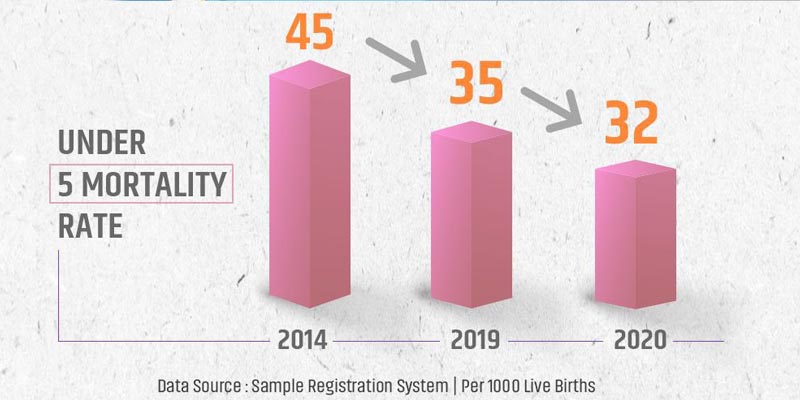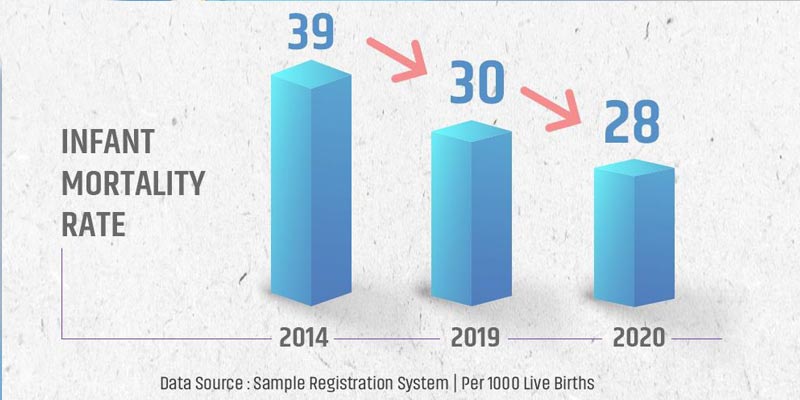- India
- Sep 24
India’s Under 5 Mortality Rate declines
India’s Under 5 Mortality Rate (U5MR) has significantly declined from 35 per 1,000 live births in 2019 to 32 per 1,000 live births in 2020, according to the Sample Registration System (SRS) Statistical Report 2020.
The country has been witnessing a progressive reduction in Infant Mortality Rate (IMR), Under 5 Mortality Rate (U5MR) and Neo-Mortality Rate (NMR) since 2014 towards achieving the Sustainable Development Goals (SDG) targets by 2030, according to the report released by the Registrar General of India.
What is SRS Statistical Report?
• The Sample Registration System (SRS) is a large-scale demographic survey for providing reliable annual estimates of Infant Mortality Rate, birth rate, death rate and other fertility and mortality indicators at the national and subnational levels.
• Initiated on a pilot basis by the Office of the Registrar General in a few selected states in 1964-65, it became fully operational during 1969-70 with about 3,700 sample units.
• The field investigation consists of continuous enumeration of births and deaths in selected sample units by resident part-time enumerators, generally anganwadi workers and teachers, and an independent survey every six months by SRS supervisors.
• The data obtained by these two independent functionaries are matched. The unmatched and partially matched events are re-verified in the field and thereafter an unduplicated count of births and deaths is obtained.
• The sample unit in rural areas is a village or a segment of it (if the village population is 2,000 or more).
• In urban areas, the sampling unit is a census enumeration block with a population ranging from 750 to 1,000. The SRS sample is replaced every 10 years based on the latest census frame. The current sample is based on the 2011 Census frame.
• At present, SRS is operational in 8,847 sample units (4,961 rural and 3,886 urban) covering about 8.1 million population, spread across all states and Union Territories.
• Mortality is one of the basic components of population change and the related data is essential for demographic studies and public health administration. It is the principal ingredient for population projections and life tables. Information on death events recorded in SRS is used to estimate mortality indicators.
• The various measures of mortality published under SRS are Crude Death Rate (CDR), Under-five Mortality Rate (U5MR), Infant Mortality Rate (IMR) and its components, Age Specific Mortality Rates (ASMR), Still Birth Rate (SBR) and Peri-Natal Mortality Rate (PMR).
Key points of the report:
• The Crude Birth Rate (CBR) at the National level during 2020 stands at 19.5 exhibiting a decline of 0.2 points over 2019. Among the bigger states/UTs, the maximum CBR has been reported in Bihar (25.5) and the minimum in Kerala (13.2). There has been a decline of 1.3 points in the CBR for the country from 2015 to 2020. The corresponding decline in rural CBR is 1.0 points and in urban CBR 0.9 points.
• The Crude Death Rate (CDR) for the country is 6.0 in 2020. The maximum CDR has been reported for Chhattisgarh (7.9) and the minimum for Delhi (3.6). During the last five years, the decline in National CDR has been to the tune of 0.5 points. The corresponding decline in female CDR is 0.7 points whereas in male CDR it is 0.3 points.
• The Infant Mortality Rate (IMR) has registered 2-point decline to 28 in 2020 from 30 in 2019 at the National level. The maximum IMR has been observed in Madhya Pradesh (43) and the minimum in Kerala (6). IMR for the country has come down to 28 in 2020 from 37 in 2015, a decline of 9 points over the last five years and an annual average decline of about 1.8 points.
• The corresponding decline in rural IMR has been to the tune of 10 points (41 in 2015 to 31 in 2020) against a decline of 6 points in urban IMR (25 in 2015 to 19 in 2020). Both the genders have shown decline in the period 2015-20. Despite this decline, one in every 35 infants at the national level, one in every 32 infants in rural areas and one in every 52 infants in urban areas still die within one year of life.
• In 2020, Under 5 Mortality Rate (U5MR) for the country has shown a decline of 3 points from 2019 (32 in 2020 against 35 in 2019). There has been a decline of 4 points in male U5MR and 3 points in female U5MR during the corresponding period. Under 5 Mortality Rate for females is higher (33) than males (31). There has been a decline of four points in male U5MR and three points in female U5MR during the corresponding period.
• Sex Ratio at Birth for the country has gone up by 3 points to 907 in 2018-20 from 904 in 2017-19. Kerala has reported the highest Sex Ratio at Birth (974) while Uttarakhand, the lowest (844).
• Total Fertility Rate (TFR) for the country has come down to 2.0 in 2020 from 2.1 in 2019. During 2020, Bihar has reported the highest TFR (3.0) while Delhi, Tamil Nadu and West Bengal have reported the lowest TFR (1.4).
• At present, the TFR of a rural woman is 2.2 at the National level, which is higher than that of an urban woman (having a TFR of 1.6).
• During 2015-2020, there has been a decline of 0.3 point in TFR at the National level. There has been a decline of 0.3 point in rural and 0.2 point in urban areas during the corresponding period.
• In the case of about 82.6 per cent live births, the mothers have received the medical attention at delivery either at government hospital or at private hospital in 2020 against the 82.8 per cent in 2019.
• There has been an increase of 0.3 percentage points in 2020 (48.8) over 2019 (48.5) in case of deaths where the deceased have received medical attention before death, either at government hospital or at private hospital. There has been an increase of about 4.4 percentage points in deaths where the deceased had received medical attention before death in hospitals during 2015-2020.
Manorama Yearbook app is now available on Google Play Store and iOS App Store


